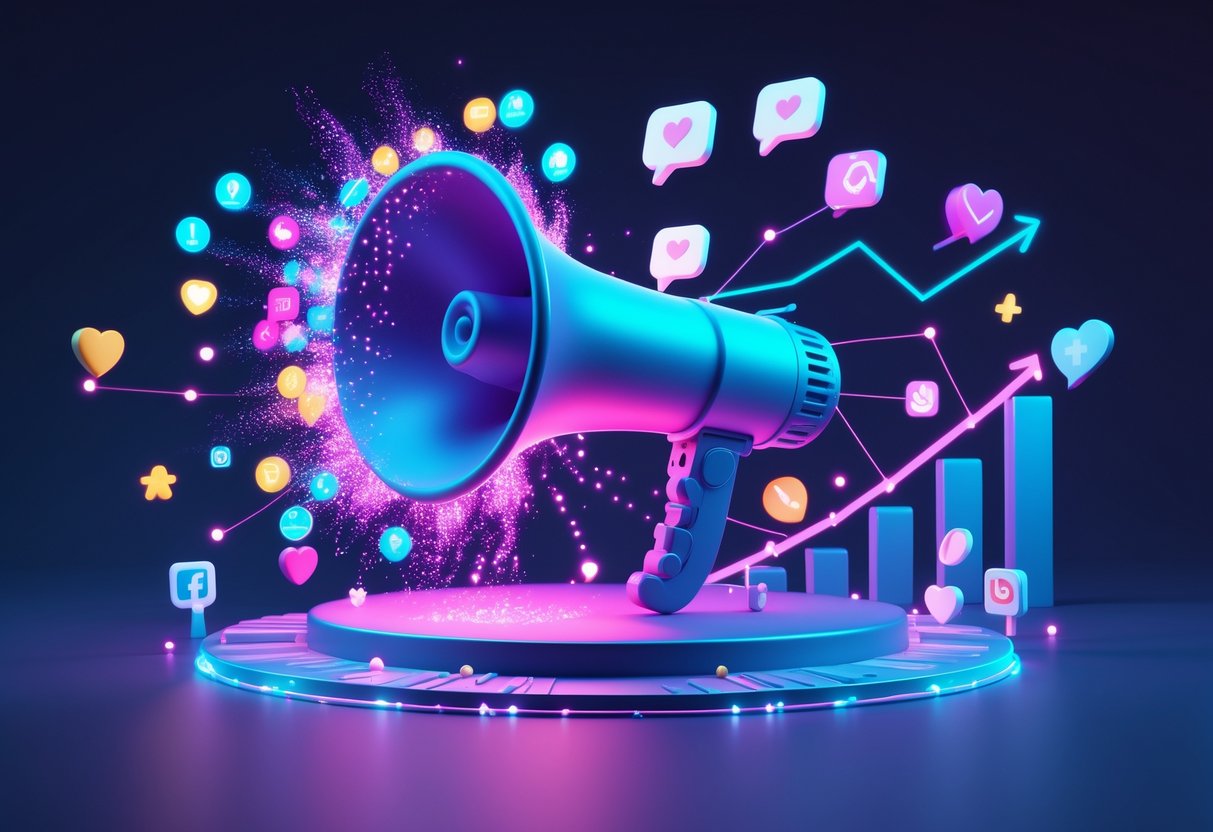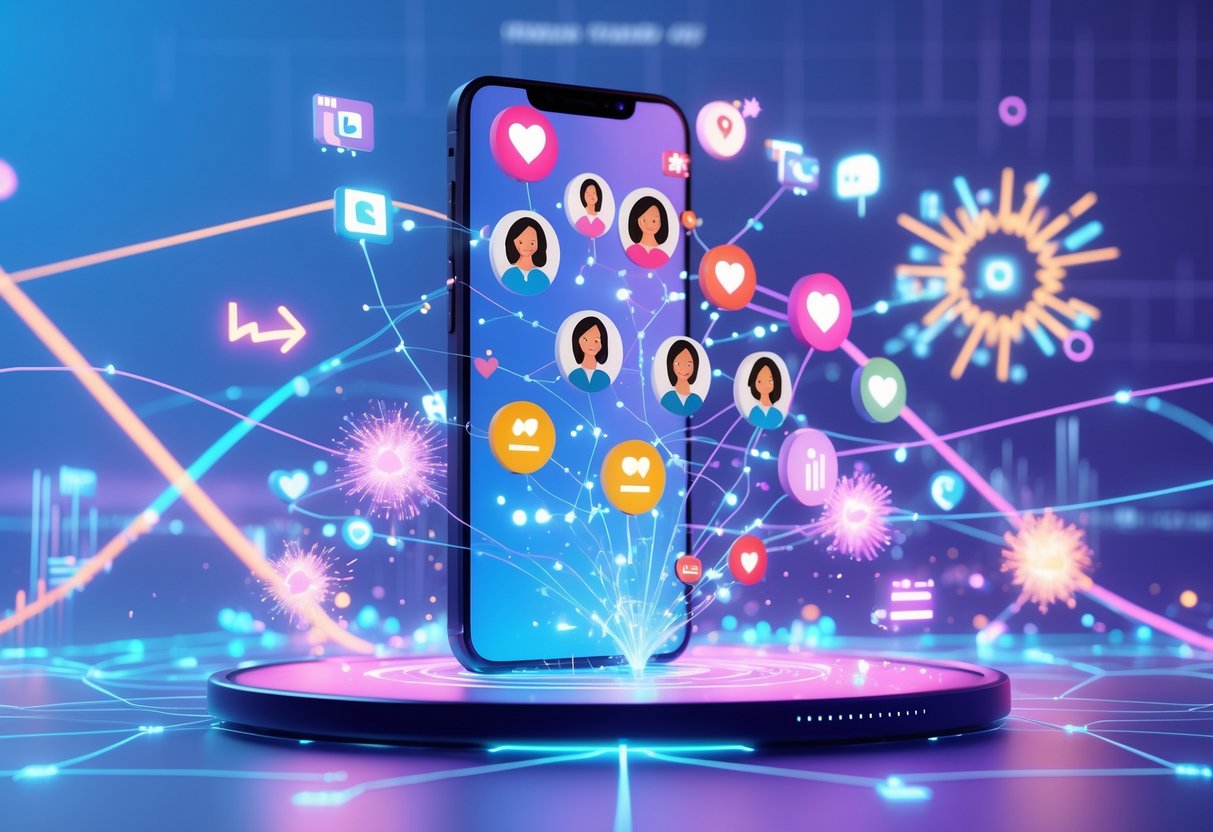Viral Potential: Unlocking Content Virality in the Digital Age
Updated On: October 23, 2025 by Aaron Connolly
Understanding Viral Potential
Viral potential measures how likely content is to spread fast across social platforms because people share and engage with it. Success comes down to certain elements that spark emotion and platform quirks that affect reach.
Key Elements of Viral Potential
Emotional triggers really drive content virality. The strongest viral potential pops up in content that sparks excitement, surprise, anger, or joy.
People love to share things that make them laugh. Humorous posts travel far because everyone wants to give their friends a reason to smile.
Timing and relevance matter a lot. Content tied to trending topics or current events taps into what people are already talking about.
Posts that go live when the target audience is online tend to get more engagement right away. That early boost can be the difference between a regular post and something that goes viral.
Simplicity is key for viral hits. If the message is complicated, people scroll past. The best viral content gets its point across in just a few seconds.
Relatability nudges people to share. When viewers see themselves in a post, they can’t help but send it to others who’ll get it too.
Phonetic Pronunciation
You say viral potential like VY-ral puh-TEN-shal.
The word “viral” rhymes with “spiral” and comes from biology—think of how viruses spread fast. In digital marketing, we borrowed the term for content that takes off in the same way.
Marketers and creators everywhere use this pronunciation in strategy chats. Getting it right definitely helps when you’re in industry conversations.
Role in Digital Marketing
Viral potential assessment lets brands decide where to put their energy. We can guess which kinds of content will click with certain audiences on different platforms.
Marketers rely on viral potential metrics to figure out the best times and formats for posting. TikTok loves entertaining stuff, while LinkedIn leans into professional insights.
Risk management becomes important when chasing viral moments. Big viral potential can backfire if people misread the message or share it in a negative way.
We think it’s smart to balance viral experiments with steady, reliable content. Most winning brands stick to 80% consistent posts and 20% wildcards.
Measuring viral potential means tracking how fast content gets shared, how far it spreads, and if it jumps to other platforms. These numbers reveal when something’s starting to take off.
Brands can then jump in with paid ads or influencer support to push content even further.
How Viral Potential Works
Viral potential works through two main things: content spreads fast across social media platforms, and users share stuff because certain triggers make them want to pass it along.
Spread Across Social Media Platforms
Content with viral potential bounces between TikTok, Twitter, Instagram, and YouTube thanks to cross-posting and tweaks for each platform. Every platform’s algorithm favors different types of content.
Platform-Specific Features:
- TikTok: Short videos with trending sounds
- Twitter: Quick text and hashtags
- Instagram: Visual stories and reels
- YouTube: Longer videos and shorts
Creators often adapt the same viral idea for each platform. A funny gaming moment might start on Twitch, get clipped for TikTok, become a GIF on Twitter, and end up in a YouTube montage.
Algorithms look for early engagement. Lots of likes, shares, and comments in the first few hours tell the system to push content out to more people.
Mechanisms of Rapid Sharing
Content spreads fast when it sparks strong emotions or gives people instant value they want to share.
Key Sharing Triggers:
- Genuinely funny moments
- Surprising or shocking clips
- Content that lets viewers feel smart for getting the joke
- Stuff that helps people express who they are
Timing makes a big difference. If you post when your audience is online, you get more eyes on your content right away. That momentum gets the algorithm working for you.
People love sharing content that makes them look good. Gaming fails, epic plays, or relatable esports moments give viewers something cool to show their friends.
Core Factors Influencing Virality
Content goes viral when it nails shareability, emotional connection, and perfect timing. When these three line up, regular posts can suddenly explode and reach massive audiences.
Shareability Essentials
Shareability is the heart of viral content. We need posts that people want to pass along to their friends.
Easy formats win. Short videos, clear images, and punchy text always beat complicated stuff. Just look at TikTok’s 15-second clips for proof.
Visual appeal matters a ton. Eye-catching graphics or thumbnails grab people as they scroll. With so much noise, you only get a second to stand out.
Interactive posts get shared more. Polls, challenges, and user-generated content pull people in. If someone adds their own spin, they’re more likely to share it.
Useful content travels fast. If a post teaches something handy or solves a problem, people naturally want to send it to others. Think “life hacks” or quick tips for better gaming.
Simple calls-to-action help too. Stuff like “tag a friend” or “share if you agree” nudges people to spread the word.
Emotional Resonance in Content
Emotional resonance decides if viewers care enough to share. Strong feelings make content stick, and people want to talk about it.
Big emotions work best. Excitement, surprise, anger, and joy all get people engaging way more than anything neutral.
Relatability makes emotions hit harder. Posts that mirror real struggles or wins connect on a deeper level. That “this is so me” vibe is huge.
Moral emotions pack a punch too. Content about fairness or community values often spreads because people want to show where they stand.
Positive emotions usually go further than negative ones. Inspiring stories, funny clips, and feel-good moments get more shares than pure negativity.
Stories from real people connect better than abstract advice. Audiences want authenticity, not just branded tips.
Timeliness and Relevance
Trending topics and current events are goldmines for viral content. If you jump into the right conversation at the right time, your reach can skyrocket.
Cultural moments matter a lot. Holidays and big events give you natural hooks for sharing content that feels relevant.
When you post really matters. Each platform and audience has its own peak times, but evenings often work best for engagement.
Fresh takes on familiar topics stand out. If you add a new spin to an ongoing trend, your content feels both timely and original.
Breaking news and quick reactions can go viral fast, but the window is short. You usually only have hours or days before the moment passes.
Seasonal content sticks around longer. Posts tied to yearly events or trends keep getting traction, unlike one-off references.
Role of Social Media in Viral Potential
Social media platforms drive viral content, plain and simple. Their algorithms and communities decide what gets seen by millions. Platform algorithms pick the winners, and community dynamics create the buzz that turns regular posts into trends.
Impact of Platform Algorithms
Algorithms control what shows up in our feeds. Each platform has its own way of ranking posts.
TikTok’s algorithm cares about watch time. If people finish your video, TikTok pushes it to more users. That feedback loop can make things blow up fast.
Instagram wants quick engagement. If your post gets likes and comments in the first hour, it reaches more people.
Twitter’s algorithm boosts content with lots of retweets and replies. Since Twitter moves so fast, viral stuff can explode in minutes.
| Platform | Key Algorithm Factor | Viral Timeline |
|---|---|---|
| TikTok | Watch completion | 2-6 hours |
| Early engagement | 1-3 hours | |
| Retweets/replies | 15-60 minutes | |
| Shares/comments | 3-8 hours |
Knowing these patterns helps you time your posts for the biggest impact.
Community Dynamics and Trends
Communities create viral moments by jumping in together. When people feel like they’re part of something, they’re more likely to share.
Trending topics take off when everyone rallies around the same hashtag or theme. The ALS Ice Bucket Challenge worked because it was easy to join and supported a cause.
Community-driven virality happens when users remix or riff on an idea. Dance challenges on TikTok or meme formats are great examples.
Social proof really matters. When you see everyone sharing something, you feel like you should too. That snowball effect can turn a small post into a massive trend.
The best viral content taps into what communities already care about, but with a fresh twist that feels real—not forced or fake.
Boosting Brand Awareness with Viral Content

Viral content changes the way people find and connect with esports brands. It creates exposure that old-school marketing just can’t match. When a post catches fire, it brings both instant attention and long-term gains for brand image.
Brand Visibility
Viral esports content brings huge reach in almost no time. A gaming clip or highlight can land in front of millions within hours, introducing your brand to people who’d never see a regular ad.
Social media algorithms love engaging content. TikTok and Twitter especially push viral esports posts to users who don’t even follow you.
Key visibility perks:
- Explosive audience growth
- Exposure across different platforms
- More brand searches and website visits
- Discovery through trending hashtags
Pro tip: Track which esports content does best on each platform, then double down during peak hours.
Improvements in Brand Perception
Viral content doesn’t just get your name out there—it shapes how gaming communities see you. When your posts genuinely click with esports fans, you build trust and credibility.
Big viral moments position your brand as part of the gaming world, not just an outsider trying to cash in. Authenticity is everything in esports, and audiences can spot a fake from a mile away.
Brand perception wins:
- More credibility in gaming circles
- Stronger emotional bonds with fans
- Greater chance of community shout-outs
- Better engagement on future posts
Gamers especially appreciate brands that truly get esports culture, player struggles, and what matters to the community. Viral posts give you the perfect stage to show you understand all that—at scale.
Crafting Viral Content

Making viral content isn’t magic, but it does take two things. You need a story that grabs people emotionally, and visuals that pop in a busy feed.
Storytelling Techniques
Great viral content tells a story people genuinely want to share. Think about gaming videos that blow up—it’s almost never just plain gameplay.
The most shareable gaming stories stick to simple patterns. They show transformation, like a newbie landing their first big win.
They highlight surprise moments—maybe an underdog team toppling the reigning champs. They pull us in through emotional connections—personal struggles, epic comebacks, or those little victories that feel huge.
Try structuring your story with these basics:
- Grab attention in the first three seconds.
- Build some tension with conflict or a tough challenge.
Show how things change—maybe it’s a win, maybe it’s a lesson learned. End on a note people want to talk about or send to friends.
A lot of successful gaming creators love the “before and after” format. They’ll show their early fails, then cut to how much they’ve improved. It feels good to watch, and even better to share.
Quick tip: Capture your genuine reactions to those wild gaming moments. Real emotions beat scripted stuff every time.
Optimising Visual Appeal
Visuals make people stop scrolling—or just keep swiping. Gaming content already has a leg up: bright colors, fast action, and those dramatic in-game moments.
Here’s what helps content get shared:
- Thumbnails: Go for bold contrasts and clear, readable text.
- First frame: Put the most exciting bit right at the start.
Use text overlays, but don’t cover up the action. Tweak the colors to pop, but don’t mess with the game’s look too much.
Most folks watch on their phones now. Always check your clips on a mobile screen—make sure text is readable and the action’s easy to follow.
Gaming videos need to work even if someone’s got the sound off. Lots of viewers scroll with audio muted. Add captions or simple visuals so everyone gets what’s happening.
Platform tweaks:
- TikTok: Shoot vertical, use big text.
- Twitter: Square videos, eye-catching thumbnails.
- YouTube Shorts: Fast edits, lots of visual changes.
The stuff that goes viral usually mixes surprising gameplay with visuals that tell the story—no matter where someone’s watching.
Metrics for Measuring Viral Potential

If you want to go viral, you need to know which numbers actually matter. Content creators should focus on metrics that show real audience connection, not just empty views.
Engagement rate tells you how much people actually care about your stuff. Conversion rate shows if viral reach leads to action.
Engagement Rate Analysis
Engagement rate sits at the core of viral potential. It tracks how many people interact—likes, comments, shares, saves—out of everyone who saw your post.
Most content hits a basic engagement rate of 1-3%. If you’re seeing over 5%, you might be onto something viral.
Early engagement speed really matters. When a post blows up in the first hour, algorithms notice and push it to more people.
Not all engagement is equal. Shares and saves mean people found real value. Comments that spark conversation? That’s gold for going viral.
Benchmarks to watch:
- YouTube: High watch time and a strong like-to-dislike ratio.
- Instagram: If your Reels get 10x your follower count in views, you’re in viral territory.
- TikTok: High share rates and people watching all the way through drive growth.
Keep an eye on engagement velocity—how fast you rack up likes and shares. A thousand interactions in an hour beats the same number over a week.
Conversion Rate Metrics
Conversion rate shows if viral reach actually does something useful for you. It’s not just about being seen—it’s about results.
Track click-throughs, website visits, or landing page hits. If your viral post isn’t converting, it’s just noise.
Saves can predict if people will come back—especially for how-to or educational videos. When viewers bookmark your stuff, you know you’re offering value.
Watch these conversion signs:
- More email sign-ups from viral posts.
- Product sales or service inquiries.
- Social follower spikes.
- Getting mentioned more often online.
Check your viral coefficient—how many new viewers each current viewer brings. If it’s above 1.0, you’re growing fast.
Don’t forget about delayed conversions. Sometimes, viral content plants a seed that pays off days or weeks later. Track results over time to see the real impact.
Influencer Marketing Strategies

Working with gaming influencers can blow up your reach—sometimes by 10x, if you get it right. The trick is picking creators who fit your audience and making sure campaigns feel real, not forced.
Leveraging Influencers for Reach
Gaming influencers connect you directly to esports communities that ads just can’t touch. Streamers and content creators have built trust with their fans over months or even years.
You’ll usually get better results with micro-influencers (1,000-100,000 followers) than with the biggest stars. Smaller creators often pull 3-7% engagement, while mega-accounts get maybe 1-2%.
Try these approaches:
- Sponsor tournament watch parties where streamers react live.
- Team up for collaborative gameplay that features your brand.
- Support influencer-run gaming events or competitions.
Brands have seen big wins by working with streamers during major tournaments. When Counter-Strike or League of Legends events go live, viewer engagement shoots up.
Quick win: Look for creators already playing games your target fans love. A Valorant streamer’s audience is all about competitive FPS.
Collaborative Campaign Examples
The best gaming campaigns mix entertainment and branding so smoothly, it just works. Totino’s pizza roll campaign with TikTok creators nailed this by targeting Gen-Z gamers during their real gaming sessions.
Formats that click:
- Gaming challenges where influencers use your product.
- Tutorials that weave your brand in naturally.
- Behind-the-scenes looks at esports events or gaming setups.
Red Bull’s esports partnerships are a great model. They sponsor tournaments, make gaming content, and back new players all the time.
Viral campaigns often invite user participation. When influencers ask their fans to share clips or join challenges, engagement can jump by 300-500%.
Heads up: If your content feels too scripted, gamers will call it out. Keep it real—forced ads flop fast.
Trend Identification and Exploitation

Viral creators keep their finger on the pulse, always tracking what’s hot across digital platforms. We use real-time data and community signals to jump on trends before they peak.
Spotting Trending Topics
We have to watch lots of sources to catch trends early. Gaming subreddits like r/GlobalOffensive and r/Valorant often light up with debates days before Twitter catches on.
Twitch chat is another goldmine. If thousands of people start spamming the same meme or question, you know you’ve found a hot topic.
Gaming news sites and Discord servers drop hints about what’s coming. Check these every day:
• Twitter trending hashtags in gaming
• YouTube search suggestions as you type game names
• Google Trends for esports keywords
• TikTok sounds that are popping up in gaming videos
Esports analysts keep an eye on tournament chatter and player drama that can blow up. These stories usually trend for three to five days, so there’s a window to create something great.
But be careful—some trends disappear in hours.
Timely Content Creation
When a trend hits, speed beats perfect production. We should have content templates ready for the usual suspects: tournament upsets, big transfers, patch notes.
Fast formats that work:
• Tweet threads breaking down wild plays
• Quick video reactions to breaking news
• Meme compilations using the latest formats
• Live commentary right when everyone’s talking
Set up a 24-hour content pipeline. Keep your editing tools open, mics ready, and social accounts primed for quick posts.
Real-time replies help you ride the wave. If you jump into trending threads with smart takes, bigger accounts might notice and share your stuff.
Aim to post within two to four hours of a trend starting. Wait eight hours, and you’ll be lost in the crowd.
Tools and Techniques for Viral Prediction

These days, creators lean on specialized tools to measure and predict what might go viral before they post. The best platforms use algorithms and data analysis to spot posts with breakout potential.
Viral Score Calculators
Viral score calculators look at things like timing, hashtags, and recent engagement to guess how well your post might do. They analyze when to post, which keywords to use, and what your audience usually reacts to.
BuzzSumo is a go-to for content analysis. It tracks shares across platforms and finds top-performing posts in any niche. It’s not cheap—£79 a month—but you get deep competitor insights.
Hootsuite Insights offers real-time viral scoring based on old data. Plug in your post, and it predicts reach and engagement. Basic plans start at £49 monthly.
ContentStudio’s Viral Predictor uses machine learning to rate your post. It checks image quality, caption length, and how often you post. Free users get five predictions a month.
A lot of creators mix and match these tools for better accuracy. Heads up: No tool can promise you’ll go viral, but they can help you spot what’s got the best shot.
Virality Measurement Platforms
Virality measurement platforms track your post’s performance in real time and break down how it spreads. They show how quickly something catches on and where it’s taking off.
Sprout Social maps out viral tracking with heat maps and timing. It highlights engagement spikes and top sharing moments. Pro plans start at £199 per user each month.
Brand24 specializes in tracking viral content across 25 million sources. It measures mention speed and sentiment during viral bursts. Small business pricing starts at £79 monthly.
Mention.com sends alerts when your content starts trending. It tracks viral coefficient and sharing patterns across platforms. Basic plans begin at £25 a month.
Most tools offer a free trial for a couple of weeks. Quick win: Try free options like Google Analytics or Facebook Insights before paying for the fancy stuff.
Case Studies of Viral Success

When you study viral campaigns, you start to notice certain patterns. Brand movements with a purpose can spread like wildfire—especially when people actually feel something.
Brand Campaign Lessons
Old Spice’s “The Man Your Man Could Smell Like” turned the brand around with humor and direct engagement. The campaign racked up over 60 million views and doubled sales.
They made a character people couldn’t stop talking about. Old Spice then replied to fans with custom videos, making viewers part of the action.
Dove’s “Real Beauty Sketches” hit 100 million views in a month by tapping into real emotional struggles. Women shared it because it felt honest and uplifting.
Dove released the video in over 30 languages and used a seeded launch strategy—starting in key markets, then going global as buzz grew.
These campaigns worked because they:
- Created emotional moments worth sharing
- Invited audience participation
- Kept up engagement after launch
- Reached beyond their usual customer base
Charitable Movements
The ALS Ice Bucket Challenge pulled in £220 million by turning a popular trend into a fundraising tool. People in 150 countries got involved because it mixed fun with a real sense of purpose.
You just had to do the challenge, donate, and then tag someone else. That cycle kept things rolling, thanks to a mix of social pressure and genuine goodwill.
TOMS’ One Day Without Shoes sparked a wave of 338,000 user photos in only two weeks. Every time someone posted a barefoot photo with the hashtag, TOMS gave a pair of shoes to a child who needed them.
Celebrities jumped in and took things to another level. When famous faces got involved, their fans wanted to join too—who doesn’t want to feel like they’re helping out with something bigger?
Both movements succeeded because they:
- Made it easy and fun to join in
- Tied small actions to a bigger social impact
- Used hashtags to keep track of the buzz
- Got celebrities on board at just the right time
Frequently Asked Questions

Viral marketing can turn an unknown brand into a household name overnight. But it doesn’t just happen by accident—you need the right strategy and a bit of luck. Looking at real examples, understanding the upsides, and knowing what can go wrong all help businesses come up with better viral campaigns.
What are some successful campaigns that demonstrate effective viral marketing?
The ALS Ice Bucket Challenge really stands out. It brought together personal dares, social sharing, and a good cause.
People filmed themselves dumping ice water over their heads. Then, they challenged their friends to do it within a day.
That campaign brought in over £100 million for ALS research. It worked because it was simple, visual, and everyone could get involved.
Old Spice’s “The Man Your Man Could Smell Like” campaign took a totally different route with humor and wild scenarios.
They made personalized video replies to fans on social media. That direct engagement made people feel like part of the joke.
Dollar Shave Club’s launch video cost only £3,500, but the CEO’s quirky delivery made it explode online.
He talked straight to the camera about how annoying shaving can be. Suddenly, a boring product became something people actually wanted to talk about.
Could you tell me about the benefits of viral marketing for businesses?
Viral marketing gets your message out fast and cheap. One good campaign can reach millions without a big budget.
When people share your stuff, brand awareness goes through the roof. Folks trust their friends’ recommendations way more than ads.
Customer acquisition costs drop a lot when things go viral. Every share is basically a personal endorsement.
Popular campaigns often get picked up by news outlets. That means even more free publicity.
Engagement rates can be three to five times higher than regular marketing. People want to join in, not just watch.
When customers feel like they’re part of something, brand loyalty grows. Viral campaigns connect people to brands in a way ads just don’t.
What different tactics are employed in viral marketing to reach audiences?
Emotions drive most viral content. Joy, surprise, even anger or fear—these get people sharing.
User-generated content campaigns get your audience involved. Hashtag challenges and contests turn followers into contributors.
Partnering with influencers helps you reach new people. Sometimes, micro-influencers get more engagement than big celebrities.
Timing is everything. Jumping on trends or reacting to big events can put your campaign in the spotlight.
Interactive stuff like polls, quizzes, and games keeps people engaged. If folks can play along, they’ll stick around longer.
Storytelling matters too. Personal stories or relatable characters make your message stick.
Can you discuss the pros and cons associated with viral marketing strategies?
Viral marketing can deliver huge reach for very little money. When it works, the payoff is massive.
But let’s be real—most viral attempts don’t take off. There’s no magic formula.
If a campaign goes well, it can build brand awareness incredibly fast. The buzz can feel electric.
On the flip side, a bad viral moment can wreck your reputation. One misstep and the internet won’t let you forget it.
These campaigns usually don’t last long. The hype fades pretty quickly.
Once your content’s out there, you lose some control. People might remix or twist your message.
It’s also tough to measure the true impact. Regular metrics often miss the bigger picture when things spread organically.
How does one craft a viral marketing strategy that’s bound to engage and spread?
No one can promise a viral hit, but you can boost your odds. Start by offering real value or genuine entertainment.
Keep your message clear and simple. If it’s too complicated, people won’t share it.
Aim for content that sparks strong feelings. Happy, surprised, or even slightly outraged folks are more likely to hit share.
Make it as easy as possible for people to pass it on. Add clear calls-to-action and make sure it’s mobile-friendly.
Pick your timing carefully. If you can ride a trend or join a big conversation, you’ll get more eyes on your content.
Be ready for anything—success or backlash. Have a plan for dealing with both.
Test your ideas with small groups first. Get feedback and tweak things to make your message even stronger.
Where might I find a reputable agency that specialises in viral marketing services?
Start by looking for agencies that actually show off case studies from real viral campaigns. If you can, ask them for specific numbers or results they’ve achieved for past clients—don’t just take their word for it.
A lot of digital marketing agencies tackle viral campaigns as part of their bigger social media game plans. Dig into their history and see if they’ve helped content go truly viral, not just get a few extra likes.
Some creative agencies focus on advertising but also dip into viral marketing. They usually love building out the big ideas and wild concepts that catch people’s attention.
Social media management companies are getting into viral marketing too. They’ve spent time learning how platform algorithms work and what actually gets people to share stuff.
Influencer marketing agencies might be worth a look as well. They already know which creators can spark engagement and get things moving fast.
Industry publications and award lists can point you toward agencies that know what they’re doing. If an agency has picked up a marketing effectiveness award for a viral campaign, that’s usually a good sign.
When you reach out, ask for a detailed proposal that explains how they’ll measure success. And if an agency claims they can guarantee you’ll go viral—maybe take that with a grain of salt.

